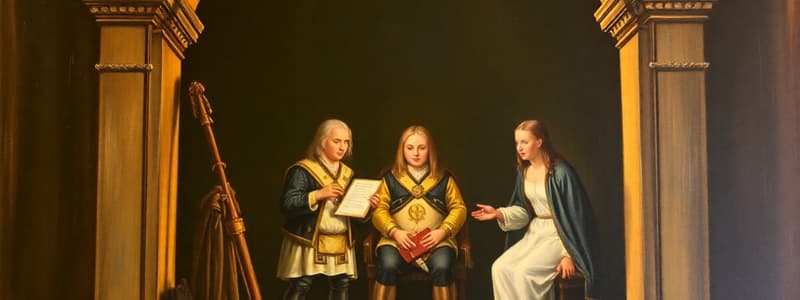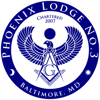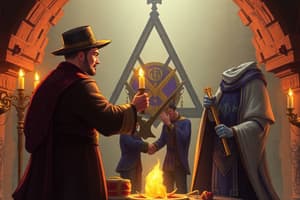Podcast
Questions and Answers
In the context of Freemasonry, what is the MOST significant function of ritualistic instruction?
In the context of Freemasonry, what is the MOST significant function of ritualistic instruction?
- To provide a social outlet for members through structured interactions.
- To test the candidate's intellectual capacity through complex questioning.
- To ensure candidates memorize key phrases and responses for formal ceremonies.
- To deeply ingrain the moral and philosophical principles of Freemasonry in the candidate's understanding. (correct)
How does the catechism primarily utilize symbolism to impart its lessons?
How does the catechism primarily utilize symbolism to impart its lessons?
- By focusing on historical symbols unrelated to moral principles to add mystery.
- By employing symbols as tools for conveying moral and philosophical lessons, making them more memorable and impactful. (correct)
- By using symbols to obscure the true meanings, revealing them only to advanced members.
- By presenting complex allegories that require extensive scholarly interpretation.
In the Entered Apprentice Degree, what is the PRIMARY significance of questions about the candidate's preparation?
In the Entered Apprentice Degree, what is the PRIMARY significance of questions about the candidate's preparation?
- To ensure the candidate fully understands the historical origins of Freemasonry.
- To ascertain the candidate's motives for joining and confirm they meet prerequisites with genuine intent. (correct)
- To verify the candidate meets the basic literacy requirements of the fraternity.
- To test the candidate's ability to memorize and repeat Masonic information.
What is the MOST profound symbolic meaning behind the dimensions, situation, and support of the lodge in Freemasonry?
What is the MOST profound symbolic meaning behind the dimensions, situation, and support of the lodge in Freemasonry?
How does the common gavel, as a working tool in Freemasonry, extend beyond its literal function to influence a Freemason's character?
How does the common gavel, as a working tool in Freemasonry, extend beyond its literal function to influence a Freemason's character?
What is the MOST nuanced interpretation of the 24-inch gauge's divisions of time in the Entered Apprentice Degree?
What is the MOST nuanced interpretation of the 24-inch gauge's divisions of time in the Entered Apprentice Degree?
In what way does the symbol of 'the point within a circle' challenge a Freemason in their daily life?
In what way does the symbol of 'the point within a circle' challenge a Freemason in their daily life?
How do secrecy, caution, and circumspection function within the ethical framework taught in the catechism?
How do secrecy, caution, and circumspection function within the ethical framework taught in the catechism?
In Freemasonry, what is the most profound implication of the parallel lines representing Moses and King Solomon?
In Freemasonry, what is the most profound implication of the parallel lines representing Moses and King Solomon?
How does the trestle board MOST significantly contribute to the operational framework and philosophical underpinnings of Freemasonry?
How does the trestle board MOST significantly contribute to the operational framework and philosophical underpinnings of Freemasonry?
Considering the transformation from rough ashlar to perfect ashlar, which philosophical concept is BEST represented by this symbolism in Freemasonry?
Considering the transformation from rough ashlar to perfect ashlar, which philosophical concept is BEST represented by this symbolism in Freemasonry?
What is the MOST critical rationale behind the emphasis on secrecy within Freemasonry, beyond the mere preservation of rituals?
What is the MOST critical rationale behind the emphasis on secrecy within Freemasonry, beyond the mere preservation of rituals?
In what way do the obligations and duties of a Freemason MOST profoundly influence their interaction with the broader community and society?
In what way do the obligations and duties of a Freemason MOST profoundly influence their interaction with the broader community and society?
How does the Entered Apprentice (EA) degree serve as a foundational element for a Freemason's subsequent journey and development within the craft?
How does the Entered Apprentice (EA) degree serve as a foundational element for a Freemason's subsequent journey and development within the craft?
What is the underlying philosophical message conveyed by the representation of the circle as 'the boundary line of a Mason's conduct'?
What is the underlying philosophical message conveyed by the representation of the circle as 'the boundary line of a Mason's conduct'?
How does the concept of 'liberty and necessity' MOST profoundly relate to a Freemason's personal development and ethical decision-making?
How does the concept of 'liberty and necessity' MOST profoundly relate to a Freemason's personal development and ethical decision-making?
Flashcards
Freemasonry Parallel Lines
Freemasonry Parallel Lines
Parallel lines represent Moses & King Solomon, liberty & necessity; point symbolizes individual Mason; circle is conduct limits.
Trestle Board
Trestle Board
The trestle board is where the Master draws designs, symbolizing the divine plan for humanity.
Rough Ashlar
Rough Ashlar
Represents a Freemason before refinement; lacking knowledge/discipline.
Perfect Ashlar
Perfect Ashlar
Signup and view all the flashcards
Secrecy in Freemasonry
Secrecy in Freemasonry
Signup and view all the flashcards
Freemason Obligations
Freemason Obligations
Signup and view all the flashcards
EA Degree
EA Degree
Signup and view all the flashcards
Significance of the EA Degree
Significance of the EA Degree
Signup and view all the flashcards
Catechism
Catechism
Signup and view all the flashcards
Purpose of Ritual Instruction
Purpose of Ritual Instruction
Signup and view all the flashcards
Fundamental tenets of Freemasonry
Fundamental tenets of Freemasonry
Signup and view all the flashcards
Catechism Structure
Catechism Structure
Signup and view all the flashcards
Candidate Preparation Questions
Candidate Preparation Questions
Signup and view all the flashcards
Symbolic Form of the Lodge
Symbolic Form of the Lodge
Signup and view all the flashcards
Entered Apprentice Working Tools
Entered Apprentice Working Tools
Signup and view all the flashcards
The Point Within a Circle
The Point Within a Circle
Signup and view all the flashcards
Study Notes
- The catechism is a method of instruction using questions and answers.
- It is used in the Entered Apprentice Degree to reinforce the lessons taught during the degree ceremony.
Purpose of Ritualistic Instruction
- Ritualistic instruction serves to imprint the teachings of Freemasonry on the candidate's mind.
- It reinforces the moral and philosophical lessons of the degree.
- It ensures a deeper understanding and retention of the principles of Freemasonry.
Key Elements of the Catechism
- Focuses on symbolism as a tool for conveying moral and philosophical lessons.
- Presents fundamental tenets of Freemasonry, such as brotherly love, relief, and truth.
- Teaches the importance of secrecy, caution, and circumspection.
- Teaches the duties a Freemason owes to God, his neighbor, and himself.
Structure of the Catechism
- The catechism follows a question-and-answer format.
- The questions prompt the candidate to recall specific details of the degree.
- The answers provide explanations and interpretations of those details.
- Contains various sections, each focusing on a different aspect of the degree.
- Includes questions about the candidate's preparation, the form of the lodge, the symbols of the degree, and the obligations undertaken.
Preparation of the Candidate
- Questions about the candidate's qualifications and motives for seeking admission into Freemasonry.
- Topics that address the candidate's free will and accord.
- The questions confirm the candidate has met the necessary prerequisites and understands the seriousness of the undertaking.
Form of the Lodge
- Focuses on the symbolic representation of the lodge as a sacred space.
- Includes questions about the lodge's dimensions, situation, support, covering, furniture, ornaments, lights, and jewels.
- Each element is explained in terms of its symbolic meaning and its relevance to the Entered Apprentice Degree.
Symbolic Working Tools
- Working tools of the Entered Apprentice: the 24-inch gauge, the common gavel, and the chisel.
- The 24-inch gauge is used to measure time, dividing it into equal portions for work, rest, and refreshment.
- The common gavel is used to knock off superfluities, representing the process of removing vices and imperfections from one's character.
- The chisel is used to further refine and shape the stone, symbolizing the education and discipline needed to achieve moral and intellectual perfection.
The Point Within a Circle
- Symbolizes the boundaries that a Freemason should never transgress.
- Represents the limits of a Mason's duty to God and his fellow man.
- Includes the parallel lines representing Moses and King Solomon.
- Represents liberty and necessity.
- The point represents an individual Mason.
- Circle represents the boundary line of his conduct toward God and man.
- The two saints John the Baptist and John the Evangelist are parallel lines who were perfect parallels in Christianity as well as Freemasonry.
Trestle Board
- Focuses on the importance of planning and guidance in Freemasonry.
- The trestle board is where the Master draws his designs.
- Enables the craftsmen to execute their work with precision and accuracy.
- Symbolizes the divine plan for humanity.
- Masons should strive to follow that plan in their lives.
Rough and Perfect Ashlar
- The rough ashlar is a stone as taken from the quarry in its natural and unrefined state.
- Symbolizes the uninitiated Freemason, who is rough and imperfect, lacking the knowledge and discipline to contribute meaningfully to society.
- Perfect ashlar is a stone that has been squared, polished, and made ready for use in the building.
- Symbolizes the initiated Freemason, who has been refined and educated through the teachings of Freemasonry, and is now a useful and contributing member of society.
- The process of transforming the rough ashlar into the perfect ashlar represents the journey of self-improvement and moral development that every Freemason undertakes.
Importance of Secrecy
- Highlights the importance of keeping the secrets of Freemasonry confidential.
- Promotes caution and circumspection in all aspects of life.
- Reinforces the idea that some knowledge should be kept private.
- Some knowledge should only be shared with those who have proven themselves worthy.
Obligations and Duties
- Emphasizes the obligations that a Freemason owes to God, his neighbor, and himself.
- Teaches the principles of morality, charity, and brotherly love.
- Stresses the importance of fulfilling one's promises and commitments.
- Masons should act with integrity and honor in all their dealings.
Significance of the EA Degree
- The EA degree is the first step in a Freemason's journey.
- Introduces the fundamental principles and symbols of Freemasonry.
- Lays the foundation for further learning and growth in the subsequent degrees.
- It is a time for reflection, self-examination, and commitment to the values of Freemasonry.
Studying That Suits You
Use AI to generate personalized quizzes and flashcards to suit your learning preferences.
Description
Explore the Freemasonry catechism, a question-and-answer method for reinforcing lessons in the Entered Apprentice Degree. This instruction reinforces moral and philosophical lessons, focusing on symbolism and key tenets, ensuring a deeper understanding of Freemasonry's principles and duties.





